Fifth Lecture Series on the History and Culture of Central Asia
During the summer semester 2023, the fifth
Lecture Series on the History and Culture of Central Asia
took place. The series of this semester was concentrated on the material culture of the Zerafshan Valley.
Apr. 11, 2023 - Gaybullo Boboyorov - "Early Muslim Coinage of Central Asia: A Blend of Arab, Persian and Turkic Cultures"
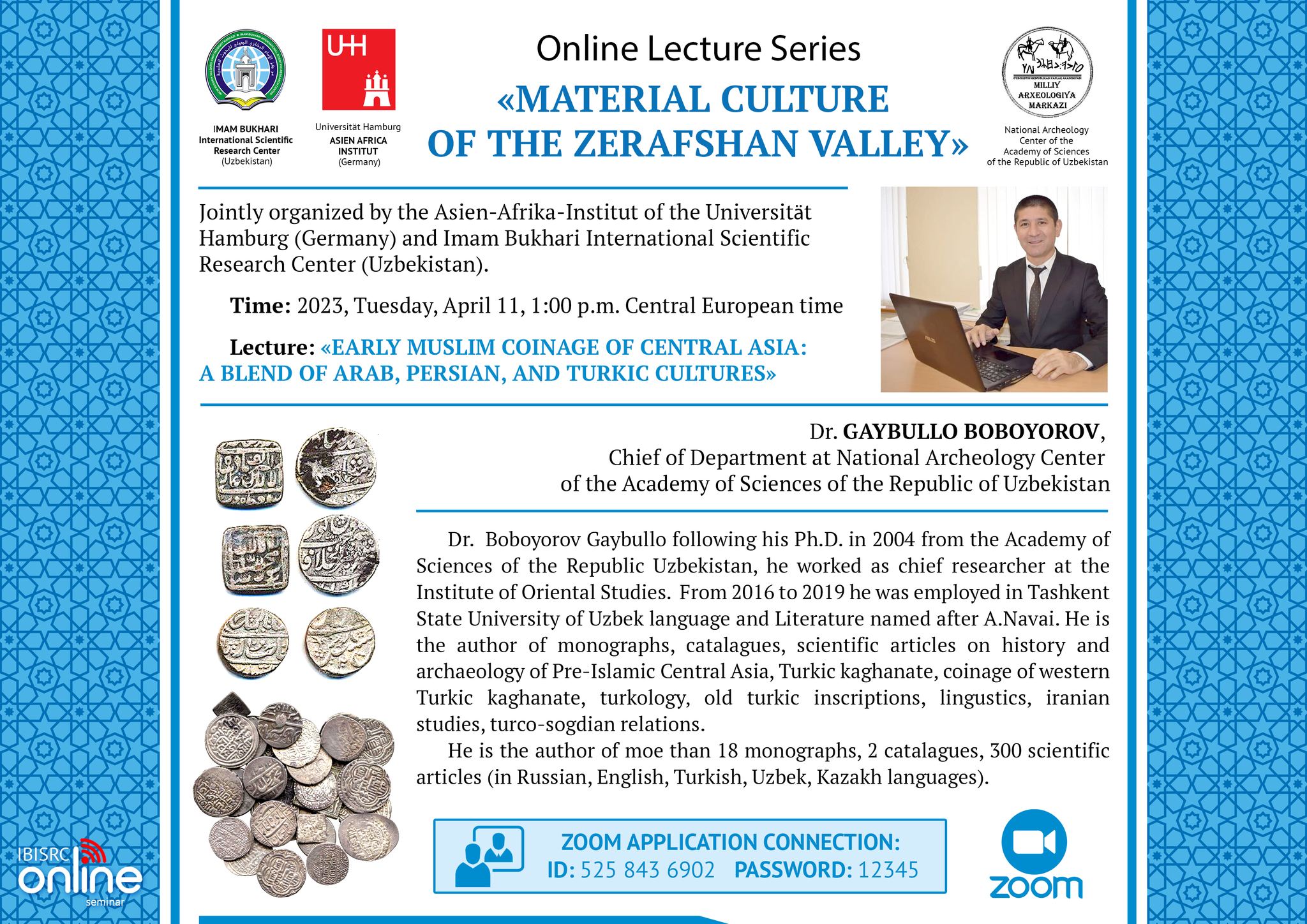
The fifth lecture series on the history and culture of Central Asia, titled "Material Culture of the Zerafshan Valley" began with a lecture by Gaybullo Boboyorov, Chief of Depratment at the National Archeology Center of the Academy of Sciences of the Republic of Uzbekistan.
The topic of the lecture, which took place online via Zoom on April 11, 2023 at 1pm CET, was: "Early Muslim Coinage of Central Asia: A Blend of Arab, Persian, and Turkic Cultures".
Bio of the Lecturer:
Dr. Boboyorov got his PhD from the Academy of Sciences of the Republic of Uzbekistan in 2004 and in the same year was appointed as cheif reserarcher at the Institute of Oriental Studies. From 2016 to 2019 he worked at State University of Uzbek Language and Literature in Tashkent. He is author of a number of monographs, catalogues, scientific articles on history and archeology of Pre-Islamic Central Asia, Turkic kaghanate, coniage of western Turkic kaghanate, turkology, old turkic inscriptions, linguistics, iranian studies and turco-sogdian relations in Russion, English, Turkish, Uzbek and Kazakh languages.
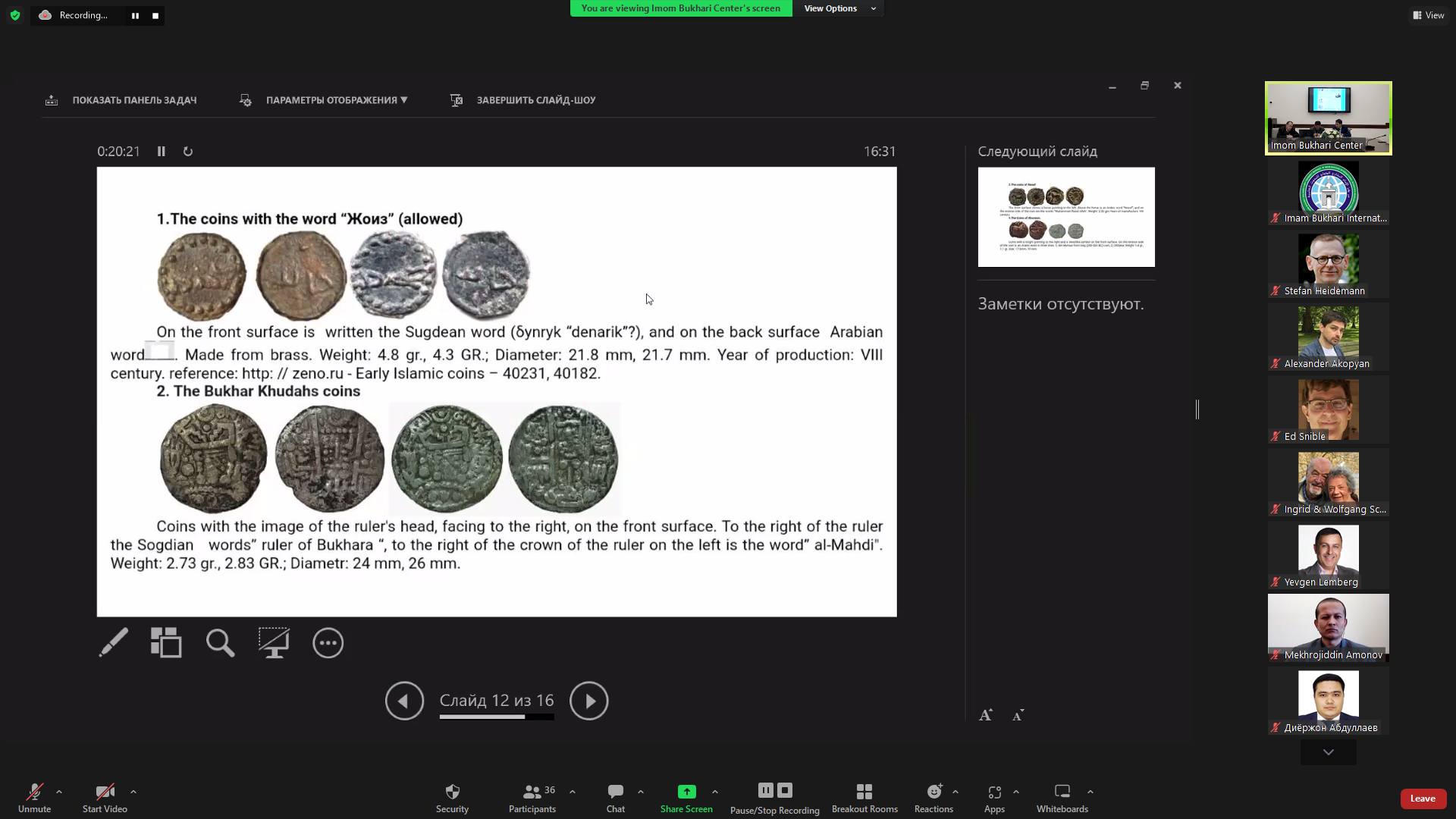
May. 2, 2023 - Simone Mantellini - "The Islamization in the Middle Zarafshan Valley"
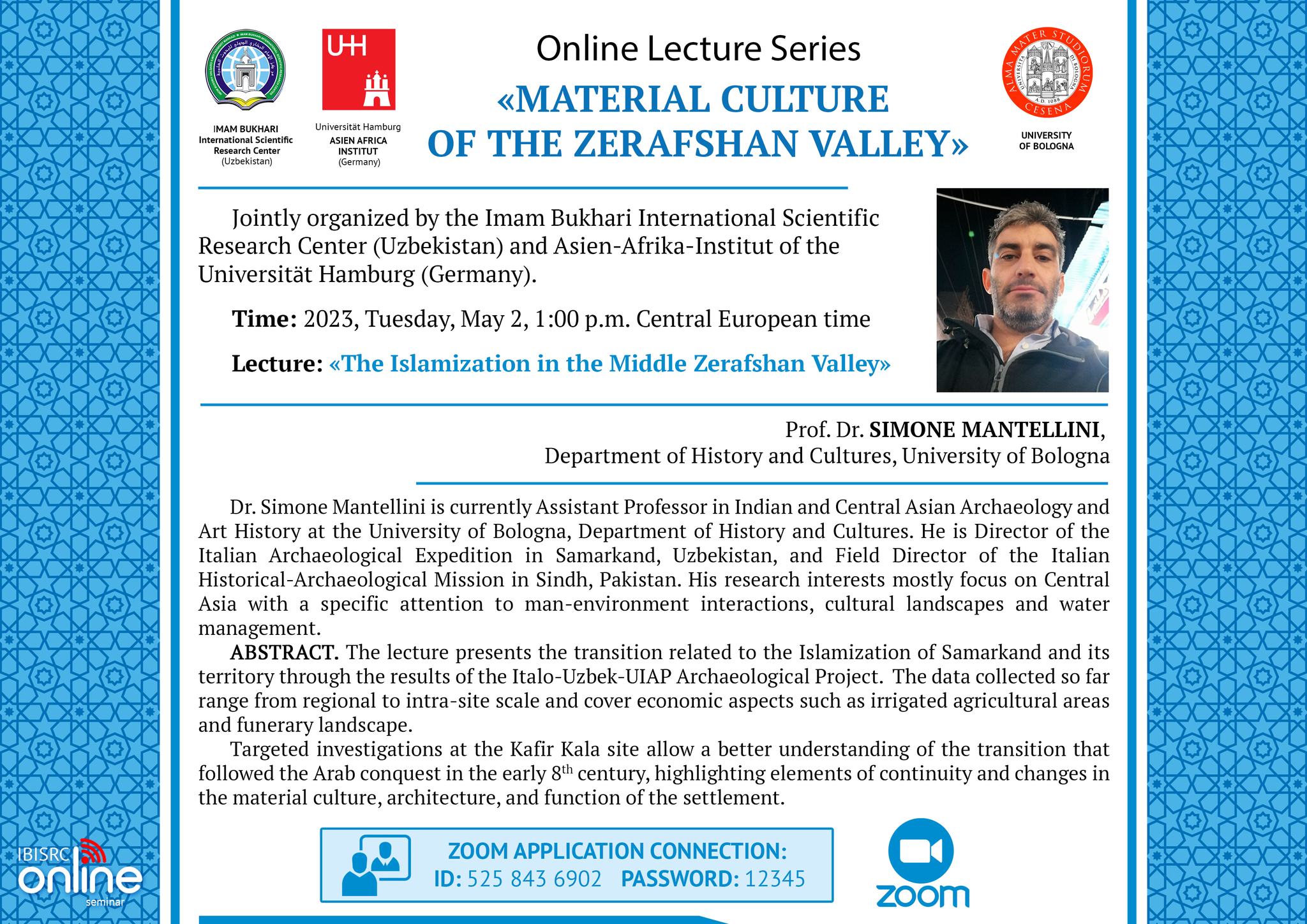
The second session of the lecture series "The Material Culture of the Zerafshan Valley '' which takes place this semester was held on May 2nd, 2023, at 1 pm CET via Zoom by Prof. Dr. Simone Mantellini, Assistant Professor at the University of Bologna and discussed the topic of “The Islamization in the Middle Zerafshan Valley”.
Abstract:
The lecture presents the transition related to the Islamization of Samarkand and its territory through the results of the Italo-Uzbek-UIAP Archaeological Project. The data collected so far range from regional to intra-site scale and cover economic aspects such as irrigated agricultural areas and funerary landscape.
Targeted investigations at the Kafir Kala site allow a better understanding of the transition that followed the Arab conquest in the early 8th century, highlighting elements of continuity and changes in the material culture, architecture, and function of the settlement.
Bio of the Lecturer:
Prof. Dr. Simone Mantellini is currently Assistant Professor in Indian and Central Asian Archaeology and Art History at the University of Bologna, Department of History and Cultures. He is Director of the Italian Archaeological Expedition in Samarkand, Uzbekistan, and Field Director of the Italian Historical-Archaeological Mission in Sindh, Pakistan. His research interests mostly focus on Central Asia with a specific attention to man-environment interactions, cultural landscapes and water management.
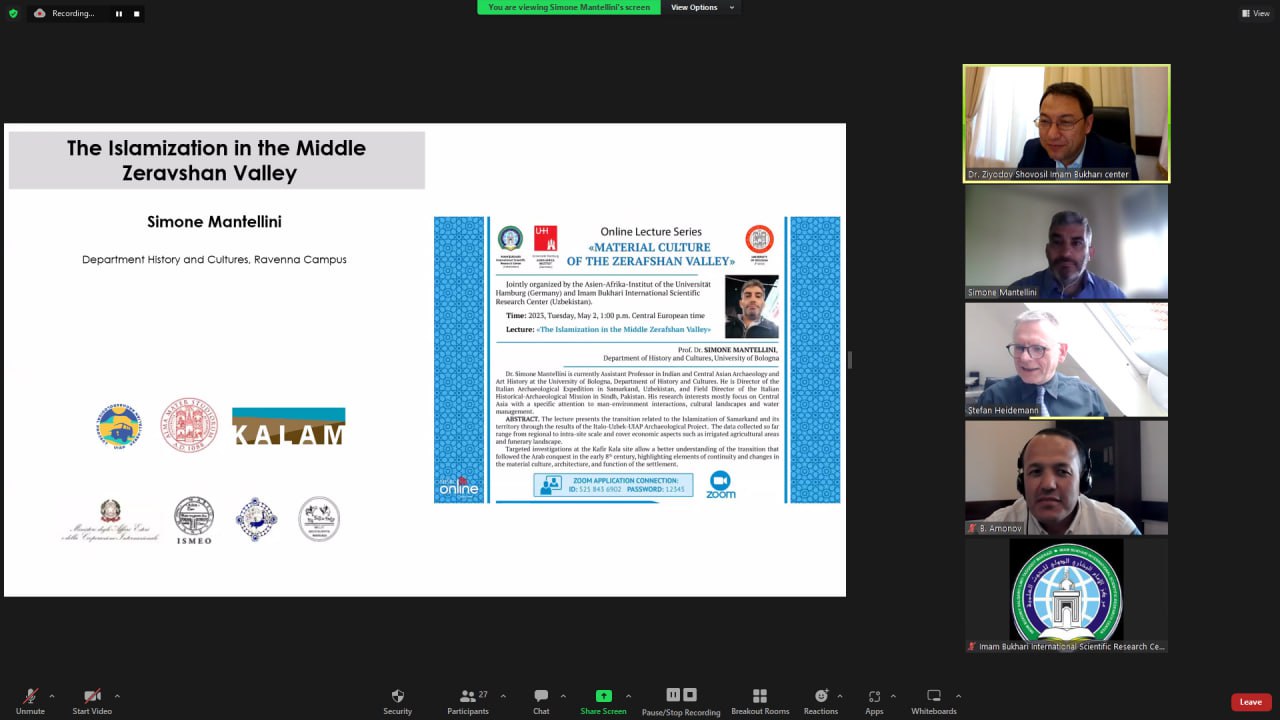
June 13, 2023 - Bobur Aminov - "Epigraphic Monuments in the Territory of Uzbekistan: Problems of Historical Research and Museification"
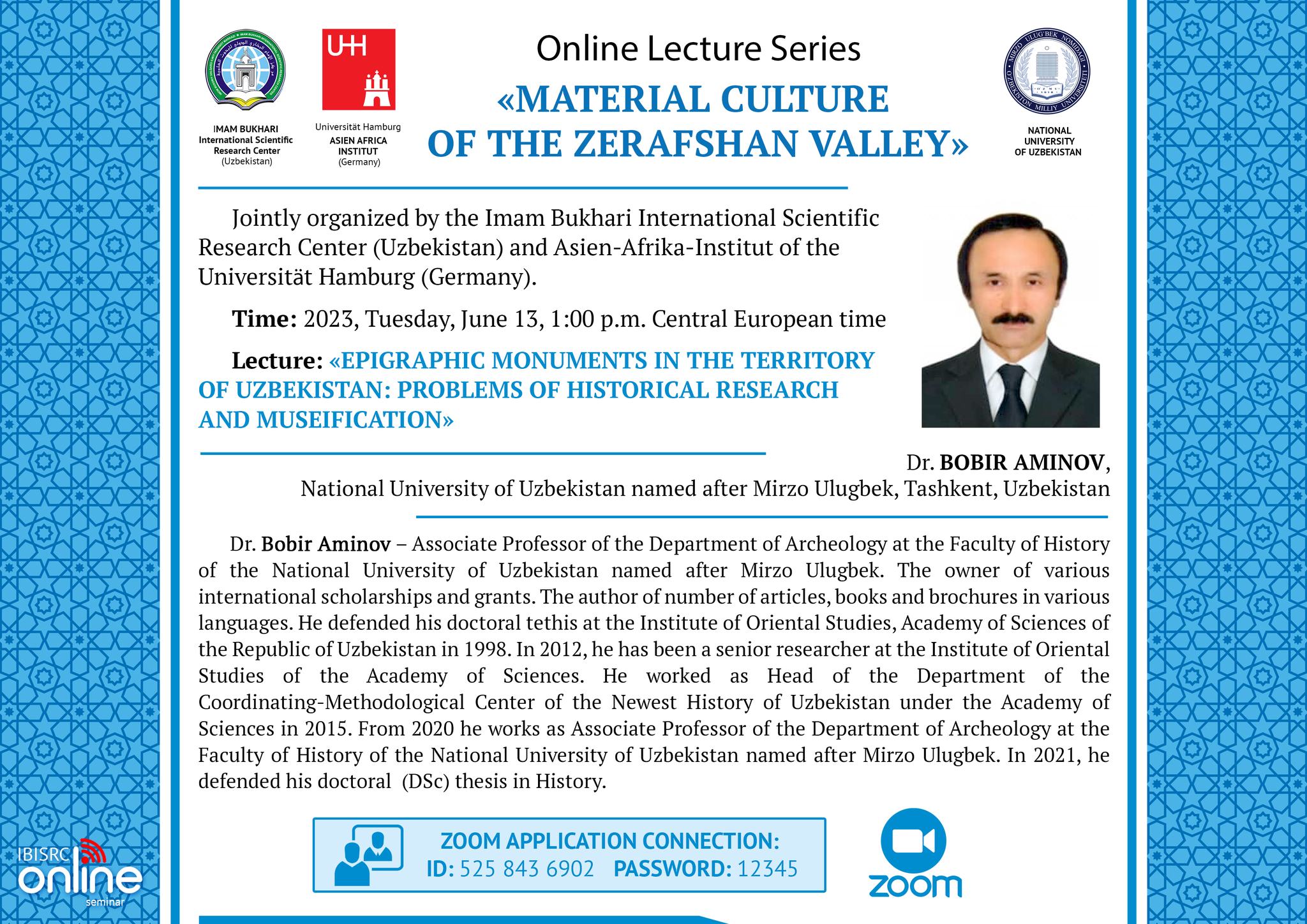
The third lecture of this semester's series, took place online on June 13, 2023 at 1:00 pm CET via Zoom. It was held by Prof. Dr. Aminov Bobur, Associate Professor at the National University of Uzbekistan after Mirzo Ulugbek, Faculty of History, Department of Archeology and disccused the topic of: “Epigraphic Monuments on the Territory of Uzbekistan: Problems of Historical Research and Museification”
Abstract:
Among the monuments of the Islamic period on the territory of Uzbekistan, a special place is occupied by architectural structures and inscriptions on stones. Such monuments contain historical information and they are among the most valuable and prolific historical sources. Therefore, it is important to study their history. Inscriptions cover the surface of historical buildings, they are on pediments, as well as on the surfaces of internal and external walls, domes, doors, arches. Inscriptions can also be found in the exhibits of various museums in Uzbekistan. Among them, a special place is occupied by such materials as glazed ceramics, metal vessels, wood, tiles, marble, limestone, brick, terracotta.
Historical inscriptions on buildings contain information about the date of construction, the architect, artist and calligrapher, and also information about his patron, or which king or ruler commissioned the construction. Unfortunately, many valuable information has vanished. In some cases, evidence about architectural structures is also determined through information from literary sources. Sometimes, during excavations in the environment of buildings, some architectural fragments are found, and if inscriptions are found, then they constitute historical evidence on the basis of paleography, material and text.
Tombstone inscriptions are better preserved and more reliable than inscriptions in architectural structures. But they were carved for an individual and can at first only provide historical information about that deаd person. Due to the durability of stone, the inscription is often well preserved for a long time. But even they can sometimes be destroyed by precipitation, especially saline and groundwater. During a survey of various tombs in Bukhara and in the Karshi valley, we witnessed that the inscriptions on the stone were eroded under the influence of underground waters and salts.
It should be noted that building inscriptions and tombstone inscriptions also serve as examples of the art of calligraphy. We can find such types of Arabic writing as Kufic, Sulsi, Naskhi, Nastalih and Tauke. They testify about the skills of calligraphers and sculptors of their time.
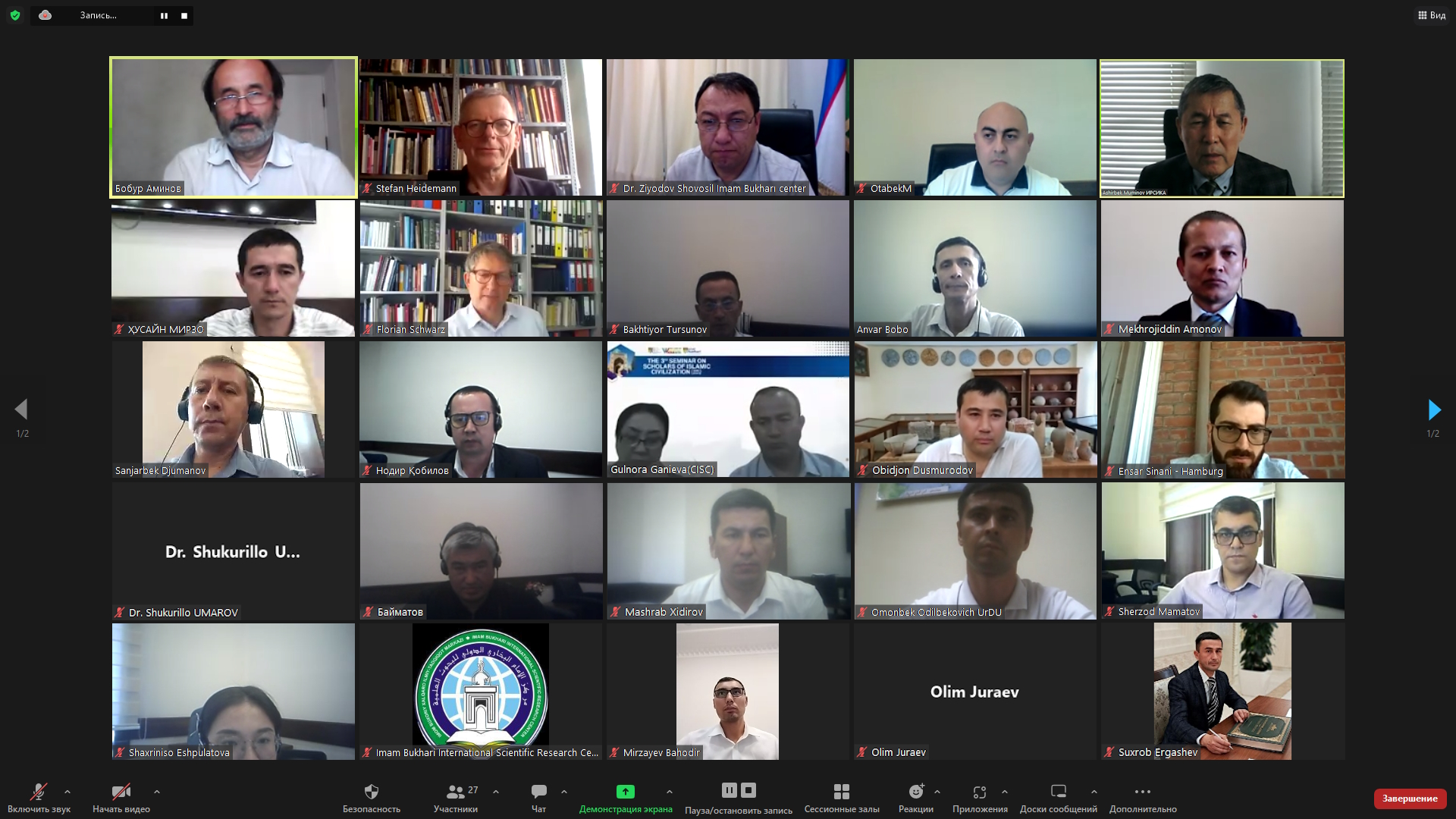
In epigraphic monuments, in addition to religious texts, examples of ḥadīths, epic tales, especially include samples of poetry. One can observe within the society and reflected in inscriptions the high level of interest in poetic literature and their cultural environment. The study of poetic examples in inscriptions sometimes allows us to restore the original poetry.
Historical buildings, tombs and cemeteries in various historical cities of Uzbekistan are in a different state of preservation, sometimes they lie in ruins, and the information in them is on the verge of loss. The preservation of tombstones in museums and complexes in the regions where they located is considered one of the most urgent tasks.
Bio of the Lecturer:
Dr. Aminov Bobur is an associate professor of the Department of Archeology at the Faculty of History of the National University of Uzbekistan named after Mirzo Ulugbek. He has received various international scholarships and grants and is the author of numerous books, articles and brochures in various languages. He earned his doctoral degree at the Institute of Oriental Studies, Academy of Sciences of the Republic of Uzbekistan in 2012.
In 2012, he was appointed senior researcher at the Institute of Oriental Studies of the Academy of Sciences of the Republic of Uzbekistan. He worked as Head of the Department of the Coordinating-Methodological Center of the Newest History of Uzbekistan under the supervision of the Academy of Sciences of the Republic of Uzbekistan in 2015. From 2020 on, he teaches as Associate Professor of the Department of Archeology at the Faculty of History of the National University of Uzbekistan.
Jul. 18, 2023 - Tim Williams - "Central Asian Archeological Landscapes Project"
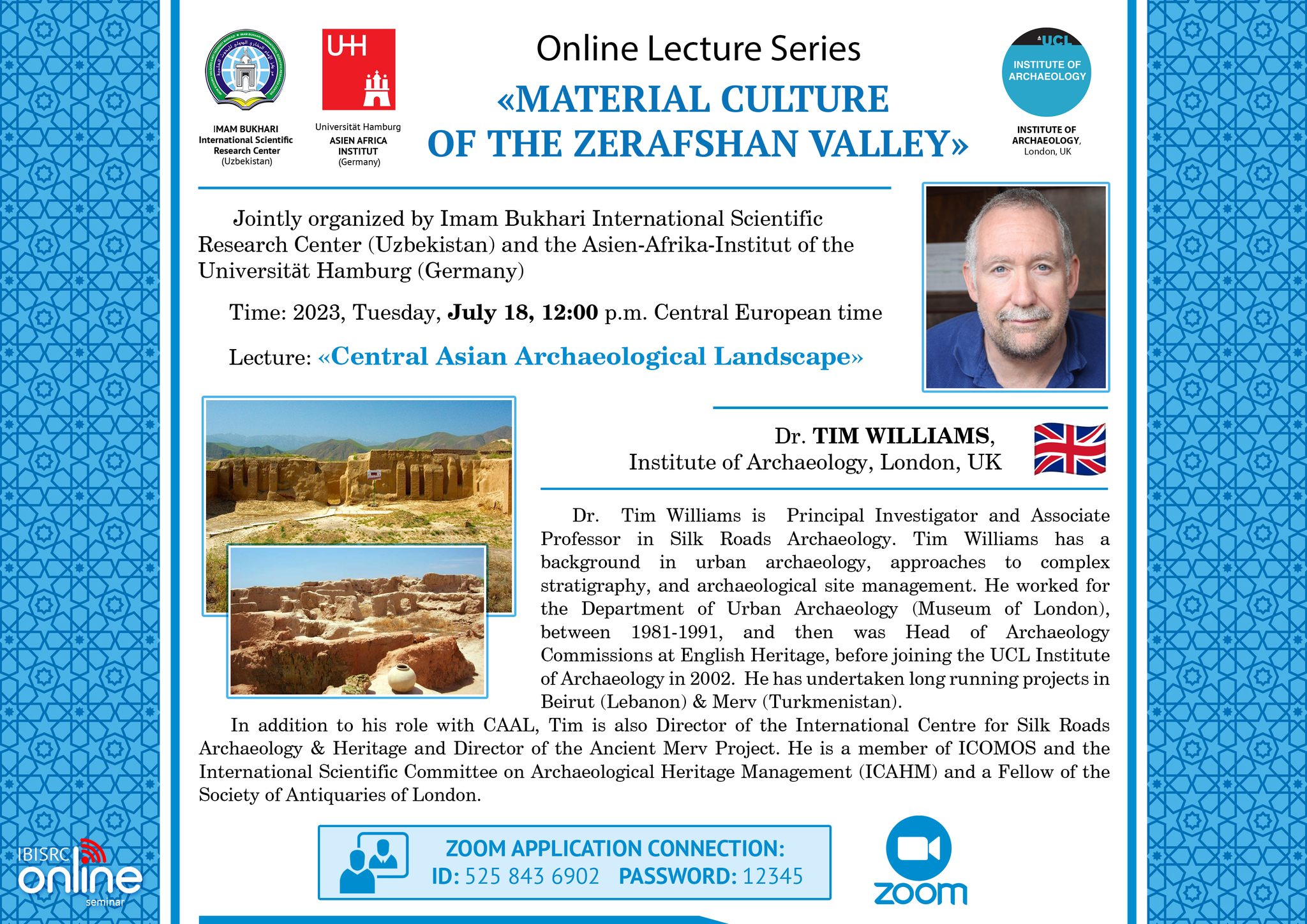
The fourth and last lecture of the summer semester 2023's series, was held by Prof. Tim Williams, Professor of Silk Road Archaeology at the University College London on July 18, 2023 online via Zoom. The topic of the lecture was "The Central Asian Archaeological Landscapes Project of The UCL Institute of Archaeology".
About the Project:
CAAL is a ten-year partnership, which started in 2019, between the UCL Institute of Archaeology, and some 20 institutions from the Republic of Kazakhstan, Kyrgyz Republic, Republic of Tajikistan, Turkmenistan, Republic of Uzbekistan, and the People's Republic of China (Xinjiang Uyghur Autonomous Region).
The project is documenting and digitising archaeological heritage in Central Asia, to raise awareness of the richness of the resource, and help to protect it. The region, from the Caspian Sea to western China, an area of about 5.7 million km2, and includes major deserts (such as the Karakum, Kyzylkum and Taklamakan), mountain chains (including large parts of the Pamirs, Tian Shan, and Hindu Kush), and fertile river deltas and oases (e.g. Zarafshan, Turfan, Syr Darya and Amu Darya). The region encompasses some of the most significant heritage of the Silk Roads, from megacities to market towns, mountain forts and desert caravanserai, complex water management systems and irrigation, and religious sites which testify to the spread of ideas and belief systems. It also includes a vitally important range of prehistoric sites, including nomadic camps and burial mounds, rock art, and significantly the spread of agriculture and early urban civilizations.
Some sites are well documented, but often information exists across many archives, and many are poorly located (in the days before GPS and accessible maps). The project is drawing together this data, protecting the disparate archives by working with them to digitising their vital information, locating sites using satellite imagery, and linking all of these with the official monument records to create a geographic information system for the national record of each country. We are identifying these using satellite images and aerial surveys (c. 60,000 have already been identified), to develop a more comprehensive understanding of the archaeological landscapes of Central Asia. A sample of these are being explored through fieldwork, interrupted by the pandemic, and we are using this as an opportunity to build capacity with local archaeologists and heritage professionals in digital approaches to documentation; including photogrammetry to create high-resolution 3D data, and using drones to accurately map extensive landscapes.
The work hopes to create a platform for research, and to assist in the protection of archaeological heritage. The fragile record of human adaption to the complex, and sometimes harsh, Central Asian landscapes is under threat from many activities: development projects, changing agricultural practices, urban expansion, and rural depopulation. In particular, the climate crisis is leading to changing patterns of irrigation because of the collapsing glaciers of the ‘third pole’ in the Himalaya-Hindu Kush Mountain ranges. The CAAL project is digitising data to explore the scale and nature of these threats. The future of heritage protection depends on strategic planning, where archaeological resources are considered as part of sustainable development policies. This cannot happen unless there is a solid, and more accessible, digital platform of information for the local agencies to work with and engage in this debate, and capacity building to ensure the skills are available locally.

